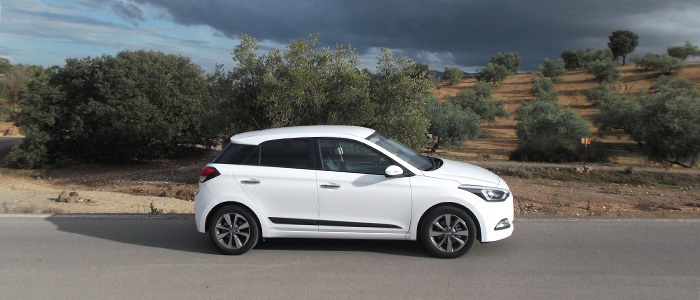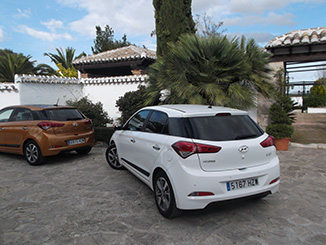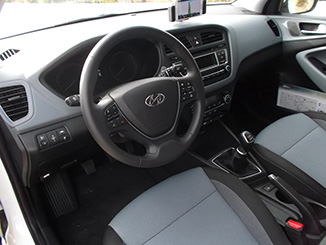Hyundai i20

European Fleet Event, Malaga
Hyundai call it the “Floating-Roofline” which is a black gloss C-Pillar that gives it the impression of a floating roofline or is that just the designers and marketing department’s pretentious way of describing it? Is the rest of the car as pretentious or is it in the real world?
This is an all-new car form Hyundai and the company’s third vehicle in the lucrative B-Sector, first there was the Getz in 2002 and the 1st generation i20 in 2009, followed by the facelift in 2012. Hyundai have sold over 1 million Getz and i20 globally, and they see the B-Sector volumes rising by a further 14% by 2017.
The new car is longer, lower and wider than the current i20. It looks more streamlined and sporty, and more in proportion. The extra length of around 45mm has made more room for passengers, and also increased luggage space by around 10%.  We arrived at the airport earlier than expected and managed to get the keys to a white 1.1 litre diesel, the car we were hoping to get our hands on, to see if this small engine was up to the job or not. We drove from Malaga airport up the coast to Nerja, then inland towards Granada, a great journey, with spectacular scenery along the way, also some testing roads for the 1.1 CRDi.
We arrived at the airport earlier than expected and managed to get the keys to a white 1.1 litre diesel, the car we were hoping to get our hands on, to see if this small engine was up to the job or not. We drove from Malaga airport up the coast to Nerja, then inland towards Granada, a great journey, with spectacular scenery along the way, also some testing roads for the 1.1 CRDi.
As we ventured towards the hills it became apparent that the 75ps was pretty good, though on one particular stretch of dual carriageway, where trucks had their hazard warning indicators going due to the fact they were going so slowly up a steep incline, we had to drop the i20 down to fourth to maintain momentum, but it kept going. On paper the 0 to 62mph time looks pretty pathetic at 16 seconds, but in reality it is not as bad as that, and we wondered if they had got their numbers wrong.
On normal roads without the steep inclines the 1.1 had enough power and tackled any situation with ease. But it was in the towns and villages that it came into its own and proved to be a very nimble city car. During the day we drove 266km on a variety of roads, and according to the on-board trip computer it achieved 6.1-litres/100km, which equates to 46.3 mpg. The engine is quiet and refined with hardly any noise transmitted to the cabin. The only noise we did pick up on was from either the door mirrors or the door seals, we couldn’t decide which, but at times, especially in cross winds on the motorway at 120kph it was noticeable.
As we went through the long tunnels they have in Southern Spain, we got chance to see the blue Interior lights that lit up all the switches and dials on the dash. They are a very nice shade of blue, and suit the car, a really well thought out piece of design work. All the switchgear is up to a very high standard and the haptics throughout the car are excellent, and certainly up to German premium quality.

Around 91% of all Hyundai cars sold in Europe are built in the region with around 300,000 built in Czech Republic and 200,000 in Turkey. We had a visit to the Izmit Plant in Turkey last year to see the i10 being produced, and we were all very impressed with the work ethic, standard of build quality there was high level of automation throughout the build process. The workers there were very proud people and they would not accept anything less than 100% quality. The new i20 is being built at the same plant so high quality should be guaranteed. Hyundai expect to sell 100,000 i20s per annum in Europe.
The model range on first glance looks a bit messy and over complicated, but when you study it, it sort of makes sense. The range starts with the S costing £10,695.00 OTR and is fitted with 1.2 litre petrol engine that produces 75ps and 112g/km CO2 emissions. Next is basically the same car with air-conditioning, and naturally called the “S-Air”, it has manual air-con, front electric windows and remote central locking, Then next is the S Blue with a 1.1 CRDi diesel engine producing 75ps and a very low CO2 figure of only 84g/km. Then next in the range is the SE, which adds 16 inch alloys, Bluetooth, cruise control with speed-limiter, lane departure warning (We have no idea why it has this feature but hopefully you can turn it off), front and rear electric windows. The range tops out with the Premium and Premium SE with a host of standard specification including: climate control, auto-dimming mirror, cornering lights, LED running lights and SmartPhone docking. The Premium has a very nice opening panoramic roof and heated steering wheel, nice on those cold winter days.
The car we drove in Spain was a bit of a mishmash of specification and did not seem to fit in with UK specification, but it had a heated steering wheel, which wasn’t need in the Spanish sunshine on a warm November day.
The one for us would be the SE 1.1 CRDi costing £14,225.00 OTR and CO2 of 103g/km, strangely the 1.1 diesel is not offered on the higher specification cars, which is a shame. Other engines available at launch include a 1.4 petrol and a 1.4 diesel. The new i20 has the standard Hyundai 5-year unlimited mileage warranty.
 A new engine will be introduced later next year in the i20, and presumably other Hyundai and KIA ranges. It is a 1.0 T-GDI Turbo 3 cylinder petrol, but little is known about this engine at this stage – more to follow in the new year.
A new engine will be introduced later next year in the i20, and presumably other Hyundai and KIA ranges. It is a 1.0 T-GDI Turbo 3 cylinder petrol, but little is known about this engine at this stage – more to follow in the new year.
The new five door, five seat i20 is a very competent and competitive B-Sector hatch that will undoubtedly attract younger buyers to Hyundai showrooms, and hopefully many more conquest sales will be achieved.
The all-new i20 goes on-sale in the UK in January with prices ranging from £10,695 to £16,725.00 OTR
An i20 coupe is due to start being produced in February, and it is a true coupe, and not a three door version of the five door.
Martin Ward, Maufacturer Relationship Manager


